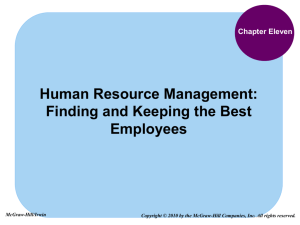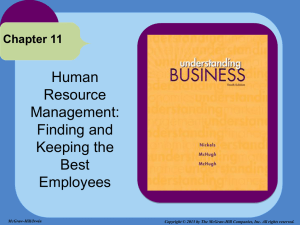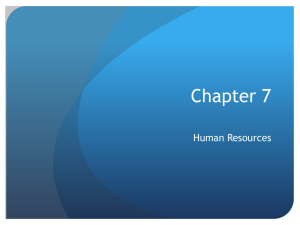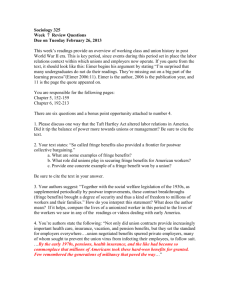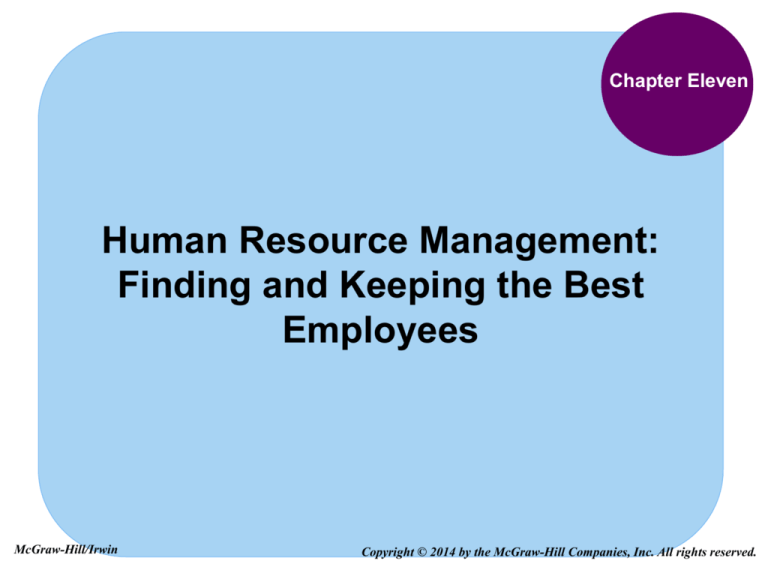
Chapter Eleven
Human Resource Management:
Finding and Keeping the Best
Employees
McGraw-Hill/Irwin
Copyright © 2014 by the McGraw-Hill Companies, Inc. All rights reserved.
HUMAN RESOURCE
MANAGEMENT (HRM)
• Human Resource Management -- The process
of determining human resource needs and then
recruiting, selecting, developing, motivating,
evaluating, compensating and scheduling employees
to achieve organizational goals.
• HRM’s role has grown because:
1. Increased recognition of employees as a
resource.
2. Changes in law that rewrote old workplace
practices.
11-2
HUMAN RESOURCE MANAGEMENT
11-3
HR & Legal Issues
11-6
CIVIL RIGHTS ACT of 1964
Title VII prohibits discrimination in hiring, firing,
compensation, apprenticeships, training, terms,
conditions or privileges of employment based on:
-
Race
Religion
Creed
Sex
Age
National Origin
11-7
1972 EQUAL EMPLOYMENT
OPPORTUNITY ACT (EEOA)
• Strengthened the Equal Employment Opportunity
Commission (EEOC).
• Gave EEOC the right to issue workplace
guidelines for acceptable employer conduct.
• EEOC could mandate specific recordkeeping
procedures.
• EEOC was vested with the power of
enforcement.
11-8
CONTROVERSIAL PROCEDURES
of the EEOC
• Affirmative Action -- Policy designed to “right past
wrongs” by increasing opportunities for minorities and
women in the workplace.
• Reverse Discrimination -- Discrimination against
whites or males in hiring or promoting.
These policies have been at the center of
many debates and lawsuits.
11-9
CIVIL RIGHTS ACT of 1991
and OFCCP
• Civil Rights Act of 1991
- Amended Title VII and gave victims of
discrimination the right to a jury trial and possible
damages.
• Office of Federal Contract Compliance Programs
(OFCCP)
- Ensures that employers doing business with the
federal government comply with the
nondiscrimination and affirmative action laws.
11-10
LAWS PROTECTING
EMPLOYEES with DISABILITIES
Americans with Disabilities Act of 1990 (ADA)
- Requires employers to give applicants with physical or
mental disabilities the same consideration for employment as
people without disabilities.
- Passage in 2008 of Americans with
Disabilities Amendments Act
expanded protection.
- 2011 saw new regulations that widen
the range of disabilities covered by
the ADA and shift the burden of proof
of disability from employees to
employers.
11-11
AGE DISCRIMINATION in
EMPLOYMENT ACT (ADEA)
Age Discrimination in Employment Act (ADEA)
Protects workers 40 and
older from employment and
workplace discrimination in
hiring, firing, promotion,
layoff, compensation,
benefits, job assignments
and training.
11-12
MINDING the LAW in HRM
• Employers must know the law
and act accordingly.
• Legislation affects all areas of
HRM.
• Court cases highlight that
sometimes it’s proper to go
beyond providing equal rights.
• Changes in law and legislation
occur regularly.
11-13
HUMAN RESOURCE MANAGEMENT
HR Must Plan for the Future
5 STEPS in the
Human Resource
Planning Process
11-14
STEPS in the HUMAN RESOURCE
PLANNING PROCESS
1. Preparing a human resource
inventory of employees.
2. Preparing a job analysis.
3. Assessing future human
resource demand.
4. Assessing future labor
supply.
5. Establishing a strategic plan.
11-15
WHAT’S a JOB ANALYSIS?
• Job Analysis -- A study of what employees
who holds various job titles do.
• Job Description -- Specifies the objectives of the
job, the type of work, the responsibilities and duties,
working conditions and relationship to other jobs.
• Job Specifications -- A summary of the minimal
education and skills needed to do a particular job.
11-16
HUMAN RESOURCE
MANAGEMENT (HRM)
The process of determining human resource needs
and then recruiting, selecting, developing,
motivating, evaluating, compensating and
scheduling employees to achieve organizational
goals.
11-17
RECRUITING EMPLOYEES
• Recruitment -- The set of activities for obtaining the
right number of qualified people at the right time.
• Human resource managers use both internal and
external sources to recruit employees.
• Small businesses often make use of web
sources like CareerBuilder and Monster to
recruit employees.
11-18
RECRUITING EMPLOYEES
•Recruiting
•Internal
•Less expensive
•Maintains morale
•External
11-19
EMPLOYEE SOURCES
11-20
THE HIRING PROCESS:
SELECTION
11-21
SELECTION
• Selection -- The process of gathering information
and deciding who should be hired, under legal
guidelines, to fit the needs of the organization and
individuals.
11-22
STEPS in the
SELECTION PROCESS
1. Obtaining complete application forms
2. Conducting initial and follow-up interviews
3. Giving employment tests
4. Conducting background investigations
5. Obtaining results from physical exams
6. Establishing trial (probationary) work
periods
11-23
CONTINGENT WORKERS
11-25
HIRING CONTINGENT WORKERS
• Contingent Workers -- Workers who do not have
an expectation of regular, full-time employment.
• Include part-time and temporary workers, seasonal
workers, independent contractors, interns and co-op
students.
• There are about 5.7 million contingent workers in
the U.S.
• Majority of contingent workers are under 25.
11-26
WHY HIRE
CONTINGENT WORKERS?
• Companies hire contingent workers:
- When full-time workers are on leave
- During periods of peak demand
- In uncertain economic times
- To save on employee benefits
- To screen candidates for future employment
11-27
TRAINING and DEVELOPING
EMPLOYEES
11-29
TRAINING and DEVELOPING
EMPLOYEES
Training and Development -- All attempts to
improve productivity by increasing an employee’s
ability to perform.
• Training – short-term skill oriented.
• Development – long-term career oriented.
11-30
MOST COMMONLY USED TRAINING
and DEVELOPMENT ACTIVITIES
• Orientation
• On-the-Job Training
• Apprenticeships
• Off-the-Job Training
• Online Training
• Vestibule Training
• Job Simulation
11-31
DEVELOPING EFFECTIVE
MANAGERS
• Management Development -- The process of
training and educating employees to become good
managers and tracking the progress of their skills
over time.
• Management training includes:
- On-the-job coaching
- Job rotation
- Off-the-job courses and training
11-32
USING NETWORKS and
MENTORING
• Networking -- Establishing and maintaining
contacts with key managers in and out of the
organization and using those contacts to develop
relationships.
• Mentors -- Managers who supervise, coach and
guide selected lower-level employees by acting as
corporate sponsors.
• Networking and mentoring go beyond the work
environment.
11-34
APPRAISING PERFORMANCE
ON THE JOB
11-35
APPRAISING PERFORMANCE
on the JOB
• Performance Appraisal -- An evaluation that
measures employee performance against established
standards in order to make decisions about
promotions, compensation, training or termination.
11-36
APPRAISING PERFORMANCE
on the JOB
A 360-degree review gives
managers opinions from
people at different levels
to get a more accurate
idea of the worker’s ability.
11-37
SIX STEPS of PERFORMANCE APPRAISALS
1. Establish Standards
Understandable
Measurable
Reasonable
2. Communicate
Standards
3. Evaluate
Performance
4. Discuss Results
5. Take Corrective/Reward
Action – if necessary
6. Use Results to Make
Decisions
11-38
MAJOR USES of
PERFORMANCE APPRAISALS
• Identify training needs
• Use as a promotion tool
• Recognize worker’s achievements
• Evaluate the firm’s hiring process
• Judge the effectiveness of the firm’s orientation
process
• Use as a basis for possible termination of a
worker
11-39
COMPENSATION
11-40
COMPENSATION PROGRAMS
• A managed and competitive compensation
program helps:
- Attract the kinds of employees the business needs.
- Build employee incentive to work efficiently and
productively.
- Keep valued employees from going to competitors or
starting their own firm.
- Provide employee financial security through wages and
fringe benefits.
11-41
TYPES of PAY SYSTEMS
• Salary
• Hourly Wage/Day Work
• Piecework System
• Commission Plans
• Bonus Plans
• Profit Sharing Plans
11-42
COMPENSATING TEAMS
• Team-based pay programs are more challenging
than individual pay systems.
11-43
FRINGE BENEFITS on the JOB
• Fringe Benefits -- Sick leave, vacation pay,
pension and health plans that provide additional
compensation to employees beyond base wages.
• In 1929, Fringe benefits accounted for less than
2% of payroll cost. Today it’s about 30%.
• Healthcare has been the
most significant increase
in fringe benefit cost.
11-44
The RANGE of
FRINGE BENEFITS
• Fringe benefits include incentives like:
- Company cars
- Country club memberships
- Recreation facilities
- Special home mortgage rates
- Paid and unpaid sabbaticals
- Day-care and elder care services
- Dental and eye care
- Legal counseling
- Short or compressed work weeks
11-45
SPECIAL PERKS at
DREAMWORKS
• Free DVDs and screenings of
current films.
• Free breakfast and lunch plus
dinner when working late.
• Free snack rooms on every
floor.
• Profit sharing.
• Ping-Pong and poker
tournaments during work
hours.
11-46
CAFETERIA-STYLE and
SOFT BENEFITS
• Cafeteria-Style Fringe Benefits -- Allow
employees to choose the benefits they want (up to a
certain dollar amount).
• Soft Benefits include:
- Onsite haircuts and shoe repair
- Concierge services
- Free meals at work
- Doggie daycare
- Onsite farmer’s markets
11-47
FLEXIBLE SCHEDULING PLANS
11-48
USING FLEXTIME PLANS
• Flextime Plan -- Gives employees some freedom to
choose which hours to work as long as they work the
required number of hours.
• Most flextime plans require Core Time -- When all
employees are expected to be at their job stations.
• Flextime is hard to incorporate into shift work and
managers have to work longer hours.
11-49
COMPRESSED WORK WEEKS
• Employees enjoy long
weekends after working long
days.
• Productivity is a concern.
• Nurses and firefighters often
work compressed work
weeks.
11-50
JOB SHARING
• Job Sharing -- Lets two or more part-time
employees share on a full-time job.
• Provides employment opportunities for many
people who cannot work full time.
• Workers tend to be enthusiastic and productive.
• Absenteeism and tardiness are reduced.
• Employers can schedule part-time workers in
peak demand periods.
11-52
MOVEMENT of EMPLOYEES
• Employees are promoted
• Employees are reassigned.
• Employees are terminated
due to performance or
economic situations.
• Employees resign
• Employees retire.
11-53
TERMINATING EMPLOYEES
• As the economic crisis grew, more and more
employers have had to lay off employees.
• Even when the economy is booming, employers
are hesitant to hire full-time workers because of
the cost of termination.
• Firing employees is more
difficult for employers
because of laws preventing
termination for certain acts.
11-54

